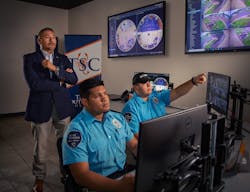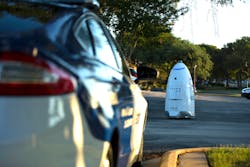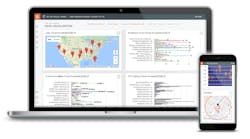The Migration to Integrated Security Solutions
From situational awareness and threat intelligence platforms to risk mitigation planning, to remote video and alarm monitoring, to GPS-based patrol route management, the migration to integrate technology-based security solutions with manned guarding has arrived in full force. Major events consistently drive technology adoption – whether it’s a hurricane, cyber threat or a pandemic, the changes typically continue post-crisis and expand as businesses understand the innate value of the new way of doing things.
The pandemic did move the needle for some companies that were on the fence about updating their security technology to improve their security risk profile. However, the wave of building integrated security solutions for businesses across all industries, had, in fact, already started years before COVID-19. It was the successful lessons from the early adopters that allowed the rapid application of these blended technology/manned guarding solutions to help businesses pivot to a new model quickly and adapt to the ever-shifting requirements of securing the “pandemic workplace”.
During a recent conversation with a Corporate Security Director at a major insurance company, we discussed the company’s need for a more efficient and reliable security program. Our initial discussion focused on new or upgraded access control, but it was soon revealed that the security professionals staffing the operation were not yet using several key features of the security systems that were already available and in place. Further review identified that multiple systems that had the built-in ability to work together were being treated independently. Both of these findings led to a realization that the building blocks for efficiency and success already existed, we just needed to tie them together.
Walking through the journey to artfully construct an integrated security solution involved discussing every tool in the toolbox. By evaluating the organization’s current state and identifying a vision for the future of its security program, we were able to create a roadmap for the security team to achieve a lean, efficient, and more reliable program. That roadmap included the integration of technology, people, and processes. Something we like to call “the connected” program.Use Cases: Tapping into the Power of AI for Integration
Integrated security allows us to augment human skills, abilities, and responses with artificial intelligence (AI). AI is transforming every sector of our economy, and security is no exception. Artificial Intelligence is taking many physical security tools to the next level. Video analytics, Incident/Case Management platforms, Security Officer Support Platforms, and more are benefitting from AI. Sophisticated AI-driven platforms can take security providers beyond the typical “detect and respond” security posture and moves them toward “anticipate and prevent.”
The best AI-driven platforms go beyond tour or incident management systems and provide a comprehensive workforce management solution using AI algorithms to project what’s most likely to go wrong at a client site and then prescribe solutions to drive better outcomes. Launched in 2019, we completed an effectiveness study for our AI platform which showed that clients, on average, experienced over a 20% reduction in safety and security incidents.
Here is a perfect example. A landmark property in Washington, D.C., which provides office space to high-profile businesses, welcomes hundreds of visitors and vendors to the property daily. The payout against a business for just one slip-and-fall lawsuit averages $15,000, so the property manager integrated AI technology with its guard force and was quickly able to use the data to make sound property management decisions on a daily basis. Better outcomes included $67,064 in savings from improvement to fire safety measures to $45,000 in potential litigation eliminated.
Consider the dilemma confronting a 100-plus bed community hospital in Texas. With homeless individuals entering the facility, aggressive panhandlers in parking areas, and other trespassers, the security team was bogged down with making frequent rounds to address perimeter security issues across its property spanning 250,000 square feet and 14 acres.
The hospital discovered a solution that freed up its security team for more critical functions by implementing AI-driven technology. Drawing on a wealth of data – from facility incidents, comparable facilities, area crime statistics, past patrols and other inputs – the AI engine used prescriptive analytics to generate recommendations that proactively adjusted officers’ patrol times and routes. Enabled with AI-powered mobile devices, the security team completed patrols faster and more effectively resulting in a 200% drop in security incidents with an enhanced safer care environment with greater staff, visitor and patient satisfaction as the number of customer complaints fell dramatically.
For a perishable foods manufacturer, an elevated temperature in a truck trailer is a critical health issue. Looking for an upgrade to their antiquated paper record keeping tracking compliance and eliminating errors, the foods manufacturer integrated AI technology with the security team. The smart AI technology provided fail-safe compliance ensuring that all required information was captured for vehicles entering or exiting the facility. That AI implementation is paying dividends with over $55 million in potential losses avoided at a single site. The manufacturer now requires that the technology be integrated at every facility they have across the country.
The Increasing Role of Robotics in the Manned Guarding Sector
The ever-increasing emergence of more highly sophisticated technology into the security sector has driven a paradigm shift for risk management, offering more opportunities for security system enhancements and program integration than ever before. Autonomous data machines (ADMs or robots), that are purpose-built for security programs, provide another tool in the integrated security toolbox to enhance the effectiveness and efficiency of security programs through the strategic integration of people, processes and technology.
Does using a robot eliminate physical security officers at a site? Absolutely not, but robots are a real force multiplier adding to the efficacy and efficiency of security programs. The use of ADM technology augments security personnel by performing necessary but not human reasoning-related tasks, allowing security professionals to focus on analytical and decision-making activities.
Threats, crime and mischief do not operate on a timetable, nor do they sleep. Robots provide 24/7 autonomous patrolling and monitoring including autonomous recharging without human intervention so that a company’s assets can be secure 24/7.
The reasons to include robots in your security program include:
- Cost savings – cost reduction without sacrificing security coverage.
- Constant Coverage - 24/7 physical security presence with autonomous patrolling and monitoring.
- Force Multiplier – More effective information sourcing and sharing, accessible in real time from the desk or on the run.
- Monitoring, Detection and Alert Capabilities – Human error is reduced with improved incident and response resolution time with analytics, information sharing and reporting capabilities.
Leveraging robotic technology with manpower has proven to lessen the burden of labor, allowing the security professionals that remain are paid higher wages, thereby resulting in more qualified and highly trained professionals with significantly reduced turnover. A mobile app allows security officers to engage with the robots and use them as tools to cover more ground and do their jobs more effectively.
Blending Manned Guarding and Advanced Technology
Texas Southmost College (TSC), established in 1926, which was selected as a Bright Spot by the White House Initiative on Educational Excellence for Hispanics, offers more than 50 programs of study leading to an associate degree or certificate. Located in Brownsville, Texas, TSC is across the street from the U.S./Mexico Gateway International Bridge, a high-traffic port of entry that poses some unique security challenges for the college. This urban environment increases traffic and vagrancy. Texas Southmost College President Jesus Roberto Rodriguez and The Board of Trustees have supported and empowered the Safety and Security Executive Director Jaime Salazar to pursue the best solution available.
The urban conditions faced by TSC provided the college with the opportunity to collaborate with its local, state, federal partners and contract a security company to ensure a safe and secure environment for its campus community.
“With our direct engagement and on-site assessment, we developed a deployment and engagement strategy for TSC, which included comprehensive surveillance, professional security services, LiveSafe -- a leading employee-sourced risk intelligence platform that offers early warning insights that can help prevent serious safety and security incidents on campuses -- and the HELIAUS reporting system with artificial intelligence-fueled analytics to assess patrol schedules and high activity areas,” says Mahsa Karimi, Director of Education, Allied Universal.
“The reporting system and robust analytics have helped us to inform our deployment strategy and assist in maximizing our resources using a risk-based approach,” says Salazar. “Analytics help us determine cost-effective deployment and risk mitigation strategies.”
“By integrating TSC’s security strategy with Allied Universal’s business strategy and staff recommendations, we have increased our security presence which serves as a deterrent,” says Salazar. “Our vision is to continue to provide a safe and secure environment for our entire TSC community. Our vendor partnership has provided us with sophisticated analytics and professional reporting, through which we have gained high visibility and a persistent security presence on campus.”
Hiring & Training Security Personnel for Integrated Security Programs
The heart and soul of an integrated security program start with a world-class security team of highly trained people to support the security mission. While many people around the country were under stay-at-home orders during 2020 and 2021, many security professionals, classified by the federal government as essential personnel, continued to report to work during the pandemic.
Today’s security professional is a highly trained employee with access to innovative technology. They are able to implement a variety of safety and health screening services. Security professionals are also collaborating with their clients to design and implement screening solutions that best fit the environment, requirements, and existing security operations. State-of-the-art technology that connects artificial intelligence and human response to better protect people with accurate real-time data and safer social interaction is the gold standard in our industry.
The professional security sector is growing exponentially and the need for security professionals to be comprehensively trained, during and beyond the pandemic, is vital. Security professionals are leaders who are a vital part of a facility or community’s safety and security – working in conjunction with local law enforcement, fire chiefs and emergency medical responders.
The future of physical security will require that we adopt more efficient and dependable technologies to adequately support future labor shortages while strengthening our security posture. Ensuring these technologies integrate with one another and the humans responsible for operating them will continue to be the focus of successful security programs.
About the Author: Thomas Walton is Senior Vice President, Vertical Markets at Allied Universal, a leading security and facility services company with 800,000 employees and revenues of approximately $20 billion. He can be reached at: [email protected].






